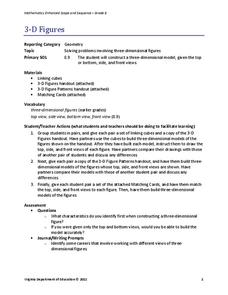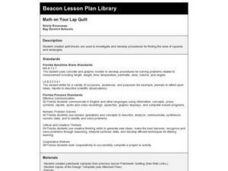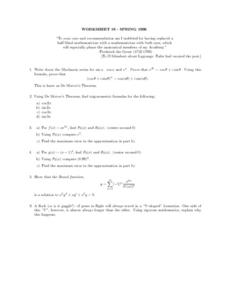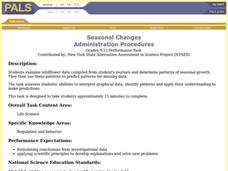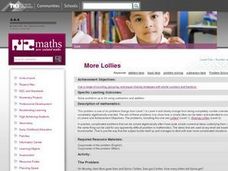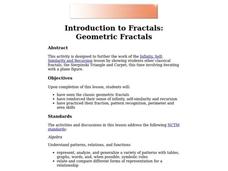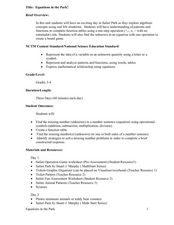Curated OER
Count by 10's
In this skip counting worksheet, students skip count by 10 to solve 6 word problems. They examine patterns, and skip count by tens to find the next three numbers or to determine the number of indicated items.
Virginia Department of Education
3-D Figures
Scholars construct three-dimensional figures to study dimension and side views. Learners build models using linking cubes to match views of different sides. After practicing with models, they attempt to match three-dimensional drawings...
EngageNY
The Structure of Ratio Tables—Additive and Multiplicative
Build tables by understanding their structure. Scholars take a closer look at the structure of ratio tables in the 10th segment in a 29-part series. Individuals realize that the tables can be built using an additive or...
Education World
The African American Population in US History
How has the African American population changed over the years? Learners use charts, statistical data, and maps to see how populations in African American communities have changed since the 1860s. Activity modifications are included to...
Curated OER
Math On Your Lap Quilt
Get creative juices flowing when you allow groups to figure out a procedure for how to find the area of squares and rectangles. They may use the individual patchwork blocks, or they may design one using the Design Template.
Curated OER
Introduction to Limits
High schoolers practice using graphing calculators and spreadsheets as they explore numeric limits using sequences and functions. They complete a sequencing worksheet, and determine which sequence corresponds to story a story called...
Curated OER
Hands Up Math
Students engage in a lesson that is concerned with the concept of using all four operations in order to create numerical expressions. They practice creating various patterns of problems that could be solved. The expressions are works of...
Curated OER
Worksheet 19-Spring 1996
In this math worksheet, students begin with the Maclaurin series and prove De Moivre's Theorem. They use the De Moivre Theorem to solve four problems. Students apply these theorems to explain why a flock of geese will fly in an uneven...
Curated OER
Mentally Add and Subtract 10 or 100
Find the missing digits in these number sequences. Each of the ten has one missing number and scholars must figure out what it is. Here's the pattern: all of these sequences involve counting by 10s. Learners add or subtract 10 to...
Curated OER
Marbles
Students act out the start of the given problem. They then brainstorm for ways to solve the problem and share solutions to the problem by identifying and continuing a repeating number pattern.
Curated OER
Flying Geese
Students examine the Flying Geese quilt pattern, and discuss and identify the pattern. They write a paragraph titled, My Quilt Report, summarizing the information discussed about the quilt patterns.
Curated OER
Math Maven's Mysteries
In these story problem worksheets, students read the story problem of 'The Case of the Mysterious Money Trail.' Students then use the information from the story to help them solve the problem. Students find a number pattern using...
Curated OER
Seasonal Changes
Students examine wildflower data compiled from their student journals from the school year. They determine patterns of seasonal growth then use these patterns to predict patterns for missing data.
Curated OER
More Lollies
Students review the days of the week and see if the students can recite he sequence using different starting days. Students retell the problem using their own words to check that everyone examines.
Curated OER
Geometric Fractals and the Chaos Game
Students define fractals and patterns. They explore how a seemingly random process can result in a pattern. Students practice probability and fractions skills by playing the chaos game online.
Curated OER
Math Sequencing Activities
Recognizing patterns and sequences in groups of numbers is an essential skill for all students to learn.
Curated OER
Follow Those Tracks
Learners observe a picture containing patterns of animal tracks, infer what might have happened based upon the pattern of tracks, and write a story describing what might have happened.
Curated OER
Introduction to Fractals: Geometric Fractals
Students study and observe the patterns made by the areas of the Sierpinski Triangle. Students use the computer to draw two or three iterations to discover the number patterns. Students complete worksheets based on Geometric Fractals.
Curated OER
Equations in the Park
Young scholars explore algebraic concepts using real life situations. In this equations lesson, students develop strategies to solve missing number problems. Young scholars participate in a board game based on algebraic equations.
Curated OER
Look at those Leaves!
Students observe leaves for patterns and similarities. For this science lesson, students sort through a pile of leaves to find patterns and take measurements. Students make leaf rubbings to view the details of the leaves.
Curated OER
Order of Operations
Young scholars analyze the Order of Operations. They play a game to explore Order of Operations and observe a PowerPoint presentation slide sow. They generate patterns and functions to represent and solve problems. Students model and...
Curated OER
Mental Math Blocks 3
In this math worksheet, students solve eleven math problems. These include finding the missing digits of an addition problem and solving a word problem about picking up pieces of trash.
Curated OER
Challenge: Into the Pool
On this area and perimeter worksheet, designers use a diagram of a Koi pool with its surrounding walkway surrounding and the appropriate mathematical formulas to solve a set of four word problems. An answer key follows the worksheet.
Curated OER
TI-89 Activities for PreCalculus and AP Calculus
Using the TI-89 calculator, students explore the statistical, graphical and symbolic capabilities of the TI-89. Students investigate topics such as solving systems of equations, finding inverse functions, summations, parametrics...



